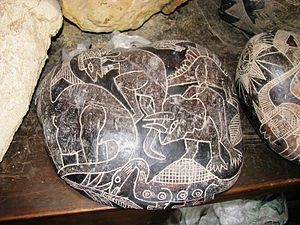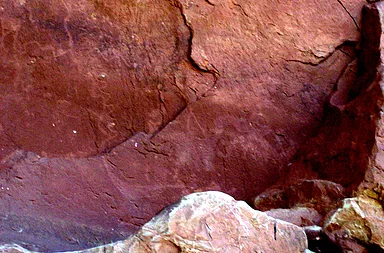@pevaquark
Did you notice my saltasaurus comment?
This is probably not the best evidence, but it is actually the one that I have conducted the most research in.
@pevaquark
Did you notice my saltasaurus comment?
This is probably not the best evidence, but it is actually the one that I have conducted the most research in.
Maybe in the future when the world’s ready for them.
@gbrooks9
What exception do I think dismantled evolution that is balderdash?
Does it unambiguously depict a saltasaurus? Can you post a photo of the stone in question, showing the dinosaur in question, here, side by side with a picture of a saltasaurus please?
(Tip: you can insert a picture into your post just by a simple copy and paste – Ctrl-C to copy it from its original source, then Ctrl-V to paste it.)
@beaglelady
Is this another, more subtle, stab at the authenticity?
The “art world” probably knows nothing of the Ica stones.
Alejandro Pezzia Assereto, a trustee of the Ica regional museum (and responsible for archaeological excavation in the area), was present for the discovery of some of the stones (this from an article in the Lima newspaper [December 11th, 1966] by Agurto Calvo, rector of Peru’s national university of engineering. In his article, Calvo argued that Alejandro Pezzia Assereto’s discoveries would lead to the logical conclusion that the Ica stones were mostly (if not all) authentic, and should merit further investigation. Later, after having the stones studied by the laboratories of the mining faculty at the national university of engineering, Calvo concluded from the results that the stones were indeed of pre-hispanic origin!
There’s more than that, but as you may have guessed, it took a tiny bit of research to assemble and summarize that information. More on this later…
@beaglelady

See it at the bottom there? I hadn’t noticed it a few years ago, but I noticed that the characteristics of that carving match almost perfectly with the picture of Saltasaurus in this convenient Scholastic dictionary of dinosaurs that I have here. Note the shape of the head, and the armor plates (or whatnot) on the creature’s back. And even if that isn’t saltasaurus, you can also clearly see another sauropod, a ceratopsian, a therapod, and apparently a stegosaurus as well! I’ll try to find a better picture…and always remember: saltasaurus was not discovered until 1980! I believe other stones as well depict things that came later than the 1960’s (meaning that they would not have been carved on the stones), but I’ll have to do some more research (yes, I’ve researched it already, but must dust off some cobwebs ![]() )
)
@jammycakes
Oh! And here’s your picture of saltasaurus too!
Let me see…
Jonathan, you seem to have some very … interesting … ideas of what “match almost perfectly” means…
Confronted by stones which may or may not be frauds, you fixate on the possibility of the stones being genuine despite the fact they come with no additional corroboration that would be necessary for them not to be fakes .
@jammycakes
You must remember, however, that the picture of saltasaurus (not the one on the Ica stone) was drawn by an artist who did not see one alive. There could have been patterns like that on the dinosaurs skin…
Also note that the saltasaurus on the Ica stone may be
Since you think the stones are forged, what do you think the forger was actually trying to draw?
And when will the world be ready?People just LOVE dinosaurs. They throng the fossil halls of the American Museum of Natural History. They pack the theaters to see the Jurassic Park movies. They buy the Dinotopia books. (And btw, the Dinotopia books also show unambiguous evidence that humans and dinosaurs lived at the same time.) I could go on and on.
It is cruel to deprive the world of these stones.
Oh come on…it had 4 legs and a tail, didn’t it?
@jammycakes
@gbrooks9
@jpm
@Jonathan_Burke
@beaglelady
@etc.
Let’s go on to some more evidence for dinosaurs and humans, other than the Ica Stones. Here is a picture I took a year or two ago:

Others have taken better pictures than I have, and you should be able to find some, but you can vaguely see the sauropod dinosaur pictured here…Thoughts?
Perhaps you have more leverage in your current life’s station to get scientists interested in the Ica stones? Or perhaps someone else does? I think they are worth another look, don’t any of you?
For the record, it had way more similarities than that!
I think a big part of the lack of credibility in artistic images of dinosaurs is that there is no scientific evidence supporting their coexistence with humans. For example, there is absolutely nothing in the fossil record that suggests that our timelines were shared. Why are there museum exhibits full of dinosaur fossils, but no fossils of modern humans? The most plausible (and even obvious) explanation is that modern humans are very new on the planet and the dinosaurs have long since left. It is difficult to accept that rock art or burial stones (forged or otherwise) is proof of dinosaur/human coexistence when there is nothing to substantiate this conjecture.
But that is my whole point! Either of these two cases makes the drawing too ambiguous to conclusively identify it as a saltasaurus!
Jonathan, it’s not just a case of thinking that the Ica stones were forged.
When the ONLY evidence we have about an artefact’s authenticity is AN ADMISSION OF FORGERY BY THE PEOPLE WHO FOUND IT, dismissing its status as a forgery as “that’s just your opinion” or something like that is completely out of touch with reality.
“Vaguely” being the operative word. I can’t make out a thing. Where are the alleged sauropods, and in any case, where were these photographs taken?
Jonathan, I’ve said before and I’ll say it again. Getting scientists interested in the Ica stones isn’t just a matter of who you know. Scientific research costs money. In other words, someone has to pay for it.
Last time I said this, you quote mined me as saying “it’s all about the money,” so I’d better make myself clear on this one. Research into the Ica stones is a cost centre, not a profit centre. It isn’t an idea that’s going to rake it in, unless you consider “raking it in” being selling the things as over-priced trinkets to gullible tourists.
If you think you that they are worthy of serious scientific research, you need to put your money where your mouth is and offer some serious scientists a grant to do so. Or if you can’t afford to do so yourself, try crowdfunding it – start up a campaign on a site such as GoFundMe to see if you can get anyone else interested.
@jammycakes
@gbrooks9
@jpm
@Jonathan_Burke
@beaglelady
@cwhenderson
@benkirk
@etc.
Hey, all. I thought of an idea for an interesting little experiment:
I would like all of you to PRIVATE MESSAGE me with the names of all (or a few) of the dinosaurs you can think of off the top of your head, and a little description of each (No Google). Since you all are highly educated individuals, I would be interested to see what all you come up with, and compare it with what was drawn on rocks by a couple relatively uneducated Peruvian farmers…I understand if you don’t want to participate, but I think it would be an interesting study…
@jammycakes
I was wondering what you think the Saltasaurus drawing was ACTUALLY supposed to be a drawing of…see what I mean?
A stylised drawing of a generic, non-specific sauropod dinosaur, drawn sometime in the mid to late twentieth century by one of the people who admitted to having done so.
Any other interpretation needs to be supported by real, tangible evidence.
At Natural Bridges Nat. Monument at the end of the Kachina Bridge trail there (Natural Bridges is in the state of Utah).
You can probably find a better picture (maybe even an enhanced one) online!
@jammycakes
Could you provide me with a link to one please?
“Let your conversation be always full of grace, seasoned with salt, so that you may know how to answer everyone.” -Colossians 4:6
This is a place for gracious dialogue about science and faith. Please read our FAQ/Guidelines before posting.